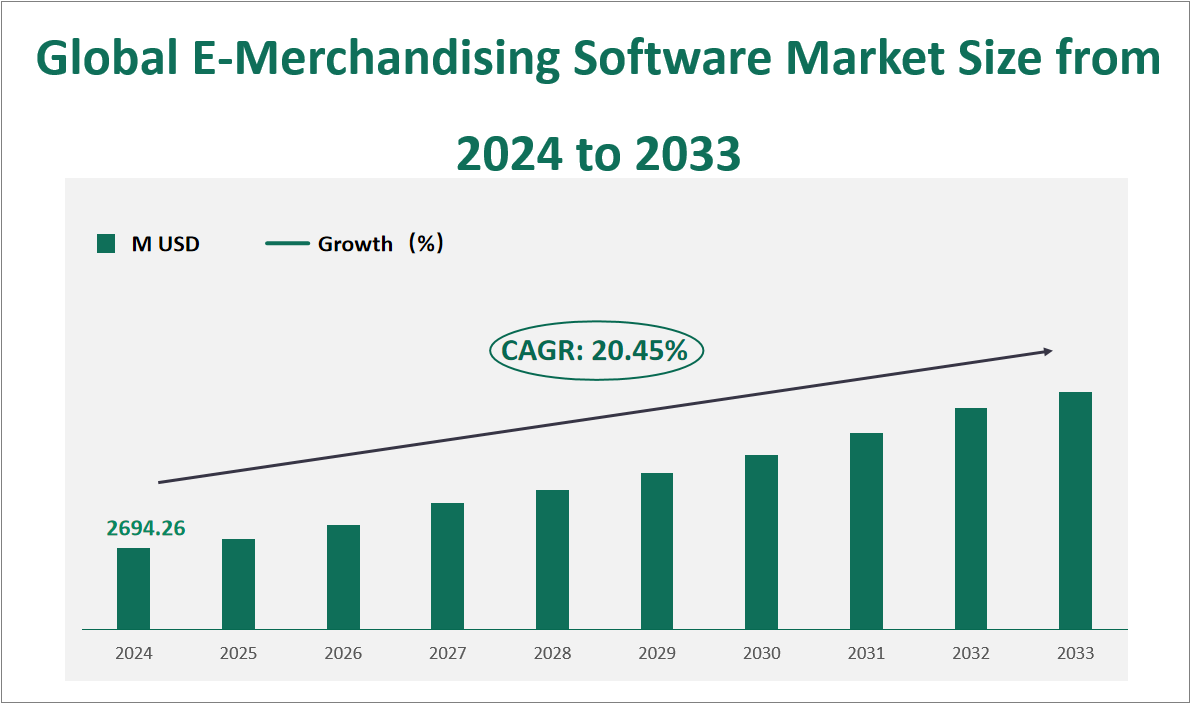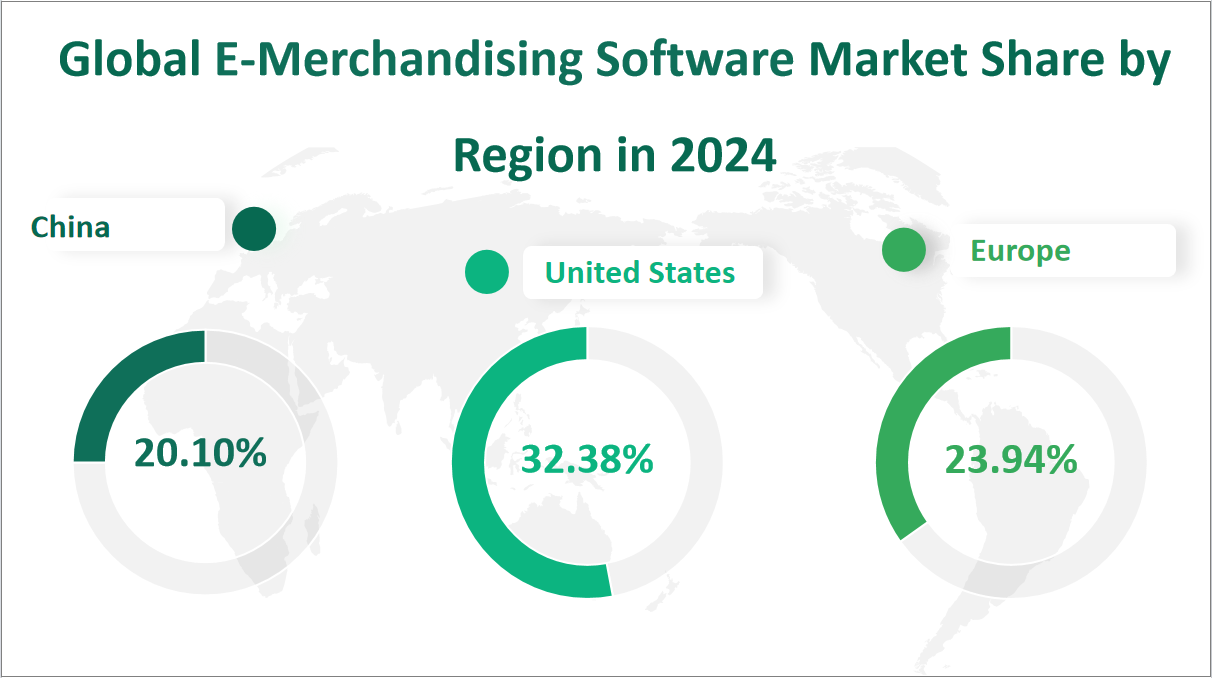1 Global E-Merchandising Software Market Outlook
The global E-Merchandising Software market is projected to exhibit substantial growth in the coming years, with a CAGR of 20.45% from 2024 to 2033, reaching a total market size of $2694.26 million USD in 2024. E-Merchandising Software, also known as viral E-Merchandising Software refers to the suite of tools and platforms designed to optimize the online retail experience. These solutions enable retailers to strategically display products, analyze customer behavior, and deliver personalized shopping experiences. By leveraging advanced technologies such as artificial intelligence (AI), machine learning, and big data analytics, E-Merchandising Software helps businesses increase conversion rates, reduce cart abandonment, and enhance overall customer satisfaction. The software integrates seamlessly with e-commerce platforms, inventory management systems, and customer relationship management (CRM) tools, providing a comprehensive solution for modern retailers.
Figure Global E-Merchandising Software Market Size and Growth Rate (2024-2033)

2 E-Merchandising Software Market Growth Drivers and Constraints
The growth of the E-Merchandising Software market is influenced by several key factors. On the positive side, the increasing adoption of e-commerce globally is a major driver. As more consumers shift towards online shopping, retailers are under pressure to enhance their digital presence. E-Merchandising Software provides the tools to create engaging and personalized shopping experiences, which are crucial for customer retention and loyalty.
Another driving factor is the need for data-driven decision-making. Retailers can leverage E-Merchandising Software to collect and analyze vast amounts of customer data, enabling them to make informed decisions about product placement, pricing, and promotions. This data-driven approach not only improves sales but also enhances customer satisfaction by delivering relevant and timely recommendations.
However, the market also faces several challenges. One significant limiting factor is the high cost associated with implementing advanced E-Merchandising solutions. Many small and medium-sized enterprises (SMEs) may find it difficult to invest in such technologies, limiting their adoption. Additionally, concerns over data privacy and security are major hurdles. Retailers must ensure that customer data is protected, especially in the face of increasing cyber threats.
Another challenge is the complexity of integrating E-Merchandising Software with existing systems. Many retailers operate with legacy infrastructure, making it difficult to seamlessly adopt new technologies. This integration process often requires significant investment in time and resources, which can be a barrier to entry for some businesses.
3 E-Merchandising Software Market Innovations and M&A Activities
The E-Merchandising Software market is characterized by continuous technological innovation. AI and machine learning are at the forefront of this trend, enabling software to predict customer behavior and deliver personalized recommendations. For example, companies like Bloomreach and Bluecore are leveraging AI to enhance their search and merchandising capabilities, providing retailers with powerful tools to optimize their online presence.
Corporate mergers and acquisitions (M&A) are also shaping the market landscape. In recent years, several notable deals have taken place, such as SearchSpring’s merger with Nextopia in February 2020, which expanded the company’s presence in the Asia-Pacific region. Another example is Nosto’s acquisition of SearchNode in January 2022, which added e-commerce search capabilities to its platform.
These strategic moves are aimed at strengthening market positions and expanding product portfolios. Companies are also focusing on expanding their geographical reach, with many targeting emerging markets in Asia, Latin America, and the Middle East. These regions offer significant growth opportunities due to their rapidly expanding e-commerce sectors and increasing internet penetration.
In conclusion, the global E-Merchandising Software market is experiencing rapid growth driven by the increasing adoption of digital solutions in retail. While challenges such as high costs and integration complexities remain, technological innovations and strategic corporate activities are paving the way for a more dynamic and competitive market landscape.
4 Global E-Merchandising Software Market Analysis by Type
In 2024, the global E-Merchandising Software market is projected to generate a total revenue of $2694.26 million USD. Specifically, the “Cloud-Based” segment is expected to contribute $1870.62 million USD, accounting for 69.43% of the total market revenue. Meanwhile, the “On-Premise” segment will generate $823.63 million USD, representing 30.57% of the total revenue. This distribution highlights the continued dominance of Cloud-Based solutions in the market, driven by their scalability and flexibility, while On-Premise solutions maintain a significant presence for enterprises with specific security and control requirements.
Table Global E-Merchandising Software Market Size and Share by Type in 2024
Type | Market Size in 2024 (M USD) | Market Share in 2024 (%) |
|---|---|---|
Cloud Based | 1870.62 | 69.43% |
On-Premise | 823.63 | 30.57% |
5 Global E-Merchandising Software Market Analysis by Application
In 2024, the global E-Merchandising Software market is forecasted to have a total consumption value of $2,694.26 million USD. For the application segments, Large Enterprises are expected to account for $927.09 million USD, representing 34.41% of the total consumption value. SMEs (Small and Medium-sized Enterprises) will contribute $1,767.16 million USD, making up 65.59% of the total consumption value. This distribution underscores the significant role of SMEs in driving the market’s consumption value, while Large Enterprises continue to play a substantial part in the overall market dynamics.
Table Global E-Merchandising Software Market Size and Share by Application in 2024
Application | Market Size in 2024 (M USD) | Market Share in 2024 (%) |
|---|---|---|
Large Enterprises | 927.09 | 34.41% |
SMEs | 1767.16 | 65.59% |
6 Global E-Merchandising Software Market Analysis by Region
In 2024, the global E-Merchandising Software market is projected to generate a total revenue of $2694.26 million USD. Among the key regions, the United States is expected to contribute $872.40 million USD, accounting for 32.38% of the total market revenue. Europe will generate $645.01 million USD, also representing 23.94% of the total revenue. Meanwhile, China is forecasted to contribute $541.55 million USD, making up 20.10% of the total market revenue. This distribution highlights the significant contributions from the United States and Europe, which are expected to lead the market, while China continues to play a crucial role in driving regional growth.
Figure Global E-Merchandising Software Market Share by Region in 2024

7 Top 3 Companies of Global E-Merchandising Software Market
7.1 Bloomreach
Company Introduction and Business Overview:
Bloomreach is a leading provider of digital commerce solutions, specializing in AI-driven search and merchandising tools. Established in 2009, the company has quickly risen to prominence by offering a suite of products designed to enhance the online shopping experience. Bloomreach’s solutions are built on the principle of delivering highly personalized and relevant content to consumers, thereby increasing engagement and conversion rates. The company operates globally, with a strong presence in North America, Europe, and the Asia-Pacific region.
Products Offered:
Bloomreach’s product portfolio includes several key solutions tailored to meet the needs of modern retailers:
Discovery: AI-powered search and merchandising tools that provide real-time insights and personalized recommendations to enhance the customer journey.
Content: A headless content management system (CMS) that allows businesses to create and manage content across multiple channels seamlessly.
Engagement: A comprehensive customer data platform (CDP) and marketing automation solution that enables personalized customer interactions at scale.
These solutions are designed to work together, leveraging unified customer and product data to deliver cohesive and optimized digital commerce experiences.
Sales Revenue in the Latest Year:
Bloomreach reported a revenue of $172.98 million USD. This significant growth reflects the company’s continued innovation and market leadership. With a gross margin of 69.40%, Bloomreach has demonstrated its ability to deliver high-quality solutions while maintaining strong profitability. The company’s market share in 2022 stood at 9.34%, highlighting its dominant position in the E-Merchandising Software market.
7.2 Bluecore
Company Introduction and Business Overview:
Bluecore is a pioneering marketing technology company that specializes in transforming casual shoppers into lifelong customers. Founded in 2013, Bluecore leverages patented shopper and product matching algorithms to deliver highly personalized shopping experiences across multiple channels. The company’s solutions are designed to optimize email, e-commerce, and paid media interactions, thereby enhancing customer engagement and loyalty. Bluecore operates primarily in North America, Europe, and the Asia-Pacific region, serving over 400 leading retail brands.
Products Offered:
Bluecore’s product suite includes several innovative solutions aimed at enhancing customer interactions:
Bluecore Communicate™: A platform for creating and managing personalized email campaigns that drive higher engagement and conversions.
Bluecore Site™: Tools for optimizing on-site experiences through personalized product recommendations and dynamic content.
Bluecore Advertise™: Solutions for enhancing paid media campaigns with personalized messaging and targeting.
These solutions are powered by AI-driven workflows that automate manual processes, ensuring consistent and relevant customer interactions.
Sales Revenue in the Latest Year:
Bluecore achieved a revenue of $136.93 million USD. This growth is attributed to the company’s strong focus on innovation and customer-centric solutions. With a gross margin of 66.63%, Bluecore has demonstrated its ability to deliver high-value solutions while maintaining operational efficiency. The company’s market share in 2022 was 7.40%, reflecting its significant presence in the E-Merchandising Software market.
7.3 Algolia
Company Introduction and Business Overview:
Algolia is a leading AI-powered search and discovery platform that specializes in delivering fast and relevant search experiences for e-commerce businesses. Founded in 2012, Algolia has established itself as a key player in the digital commerce space by offering solutions that enhance search relevance and personalization. The company’s platform is designed to improve customer engagement and drive conversions by providing seamless and intuitive search experiences. Algolia operates globally, with a strong presence in North America, Europe, and the Asia-Pacific region.
Products Offered:
Algolia’s product offerings include several advanced solutions tailored for modern retailers:
AI-Driven Search: Tools that leverage machine learning to deliver highly relevant search results, ensuring that customers find what they are looking for quickly and easily.
E-commerce Search: Solutions that optimize search functionality for online stores, enhancing the overall shopping experience.
Personalization: Features that enable businesses to deliver personalized content and recommendations based on customer behavior and preferences.
These solutions are designed to work seamlessly with existing e-commerce platforms, providing a comprehensive search and discovery experience.
Sales Revenue in the Latest Year:
Algolia reported a revenue of $96.83 million USD. This growth underscores the company’s continued innovation and market leadership. With a gross margin of 63.29%, Algolia has demonstrated its ability to deliver high-quality solutions while maintaining strong profitability. The company’s market share in 2022 stood at 5.23%, highlighting its significant presence in the E-Merchandising Software market.

